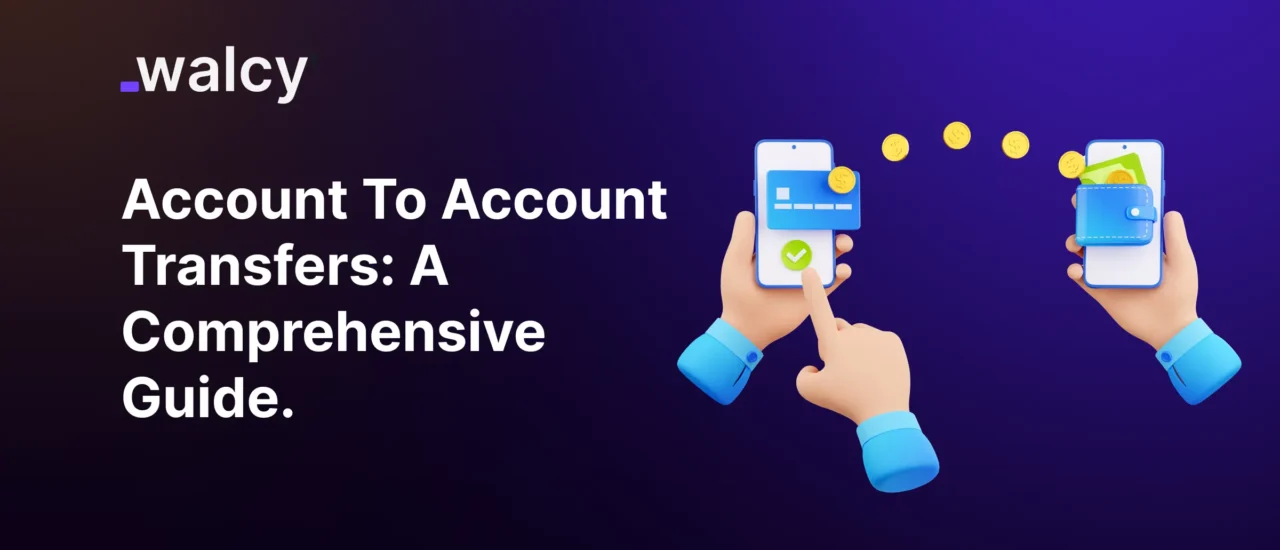In the world of changing financial transactions, account to account transfers are important in facilitating fast money transfers between accounts. This blog looks into the details of A2A transfers: what they are, how they function, their advantages and disadvantages, and the variety of tools available to support them.
What is an A2A Transfer?
Account to account transfers, commonly referred to as A2A transfers, are direct transfers from one account to another. It is unlike most means of payment, where intermediaries or third-party service provision may be required, but instead, it makes the process of executing an A2A transfer very straightforward, directly from account to account.
This is usually hassle-free when wrong sending of money is common, and sometimes delays transactions due to the chain of procedures taken. These transfers are widely accepted for the ease factor in personal and business transactions.
How A2A Payments Work?
In the case of an A2A transfer, the initiation would be when the account holder initiates a transaction from his account. The transaction details are dispatched to the banking system, which processes the transfer by sending a hit on the sender’s account for debit and on the recipient’s account for credit. This involves:
Initiation: It is started by the account holder, online through Internet banking, a mobile phone application, or physically at the bank branch. During this stage, the transfer amount and recipient details are filled in.
Authorization: During this step, the bank checks whether the details of the transaction are correct and that the balance of the sender is sufficient. As well as the account details of the recipient, fraud and security checks form part of it.
Processing: The bank clears the transaction, followed by the transfer wherein the money moves from one account directly to the other. This includes the actual movement internally within the systems at the bank or across the networks of banking.
Completion: The transferred amount credited into the recipient’s account and the corresponding deduction from the sender’s account complete the process. These are then recorded in the transaction history of both accounts for future reference to the executed transfer.
Read more about: International B2B payments
Benefits of A2A Payment Processing
- Cost Efficiency
A2A transfers in most cases charge less compared to other channels of transfer, mainly wire transfers and payment processors. Because they substitute the intermediaries, the cost of processing comes out lower, and eventually, that helps positively the business or a person. This efficiency is very important when frequent or high-volume transactions are involved; every bit of savings counts.
- Speed
Transfers can be done instantly or on the same business day, depending on the banks involved and the form of A2A transfer being used. This will greatly help payments concerning time-critical measures so that the payee does not have to worry about the delay in transferring funds.
- Convenience
Numerous platforms online allow transfers between account to account which makes it easier for customers. This means that customers can do transactions of this sort without necessarily going physically to any bank or branch. The feature of being able to manage transfers remotely provides convenience in time and effort not only for personal but also for business purposes.
- Security
In general, A2A transfers are secure since they include encryption and secure channels to protect sensitive financial information. The direct nature of the transfer reduces the risk in errors or fraud compared to other methods of payment.
You shall love: International Payment Fraud: Ultimate Guide For Businesses.
Types of A2A Transactions
- Internal Transfers
These occur with the same bank, such as transferring from one savings account to another or between checking and savings accounts. In general, they are free and immediate, since they do not interface with outside banking systems. This is because of the direct linkage of accounts within the same banking system. Transfers internally are some of the most common for budgeting and managing one’s finances; hence, they are convenient for frequent transactions.
- External Transfers
These range from the transfer of funds between different banks. It involves interoperability between systems of different banks. Although adding some level of complexity to the process, at least external A2A transfers are still prompt and economical, usually taking just a few hours up to a few days to conclude. A small fee might be applied, given the policies of the banks and the speed at which the transfer is to occur. External transfers are convenient in sending money to accounts in various financial institutions for personal and business needs across banking networks.
Account to Account Transfer Charges
Bank Policies: The fee policy of various banks for A2A transfer varies. While some institutions offer their services free of cost, others might charge a nominal fee for the same. Moreover, banks may also offer different fee tiers depending on account type or customer status, so it’s a good idea to review your bank’s fee schedule.
Transfer Type: Transfers within the same bank are usually free since these are simple and less burdensome on the bank. However, external transfers, wherein different banking institutions are involved, may involve some charges since interbank communication and processing are required.
Speed: The charges for A2A transfer may also depend on the speed of the transfer. Those that are expedited or occur instantly generally incur extra fees when one considers the standard timing, where the processing is not as rushed but affordable. This helps users balance their needs between cost savings and urgency.
Fee Transparency: In the case of A2A transfer, it will be worth asking the bank about their different fee arrangements. Knowledge of the various transfer fees helps arrive at more realistic decisions and avoid unwarranted additional expenses. Some banks also extend concessions or exempt charges that come on high-balance accounts or a greater number of transactions.
You shall love: Hidden Bank Fees: What Are They and How to Avoid Them?
Tools and Apps for A2A Money Transfer
- Banking Applications
In matters of holding and transferring money, nearly all financial institutions today have embraced the rapidly growing trend of offering mobile and online banking applications. These applications provide simple interfaces with their customers for conducting A2A transfers.
- Payment Platforms
A few third-party payment platforms and financial technology services allow A2A transfer. They are generally capable of various functions, such as scheduled transfers or integrating into other financial tools.
- Personal Finance Applications
Many of these personal finance apps have the functionality that goes towards managing A2A transfers. These apps will help users track all of their transfers while taking care of their finances from just one place.
Read more about: Transferring Money To Foreign Bank Account. Essential Tips To Know.
Advantages and Disadvantages of A2A Transfers
Advantages of A2A transfers include being less expensive because such transactions cost less when fees are considered against other payment instruments, which involve some intermediary. The straight-through nature of A2A transfers assures their ability to move much quicker, often even instantaneously, and be supported by online and mobile services that reduce the need for actual bank visits. Moreover, A2A transfers are very secure because of encryption and secure channels that do not permit the exposure of financial information, thereby reducing fraud cases.
The disadvantage of A2A transfers may also include imposed fees on external transfers from one bank to another, possibly if the bank’s policies dictate so. While transfers within a bank may be free, transferring to another bank may incur some charges and take time to reconcile. There are also speed discrepancies between regular and expedited transfers, which may affect the convenience of using A2A transfers when urgent transactions are necessary. Moreover, some users may encounter certain limitations based on their bank’s transfer-specific policy or technological capability.
Read more: International Money Transfer Charges | How Much Does It Cost?
Conclusion
A2A transfers are direct bank-to-bank transactions in a way that is less restrictive and more seamless; thus, lower fees, faster processing, and convenience abound. Add to this the convenience of being able to make transfers through online and mobile banking, and access to financial management just got easier, and less dependent upon traditional banking. Transfers from A2A are far cheaper and much safer not only for personal but also for business transactions, hence the alternative is valid in modern times.
Still, one should not forget certain disadvantages: commissions for the external transfer, and differences in time taken for processing. Whereas internal transfers are usually free and instant, external transactions may involve some cost and more time since it depends on banks. Knowing these factors and asking your bank about its policy will make you execute A2A transfers with maximum efficiency and without unexpected charges and delays. All in all, A2A transfers mean a modern way of managing one’s finances conveniently, provided the users are aware of some considerations that come tagged along with them.
Check more about A2A transfer in this blog.
Frequently Asked Questions (FAQs)
Are A2A transfers free?
Internal A2A transfers within the same bank are often free. However, external A2A transfers between different banks might incur charges, depending on the banks’ policies.
How long does an A2A transfer take?
Internal transfers are usually processed instantly. External transfers can take a few hours to a few business days, depending on the banks and the type of transfer.
Can I use A2A transfers for international transactions?
Yes, A2A transfers can be used for international transactions, though they may involve higher fees and longer processing times compared to domestic transfers.
How can I check the fees for an A2A transfer?
To find out about the fees for A2A transfer, you should consult your bank’s fee schedule or contact their customer service for specific information related to your account and transfer type.



